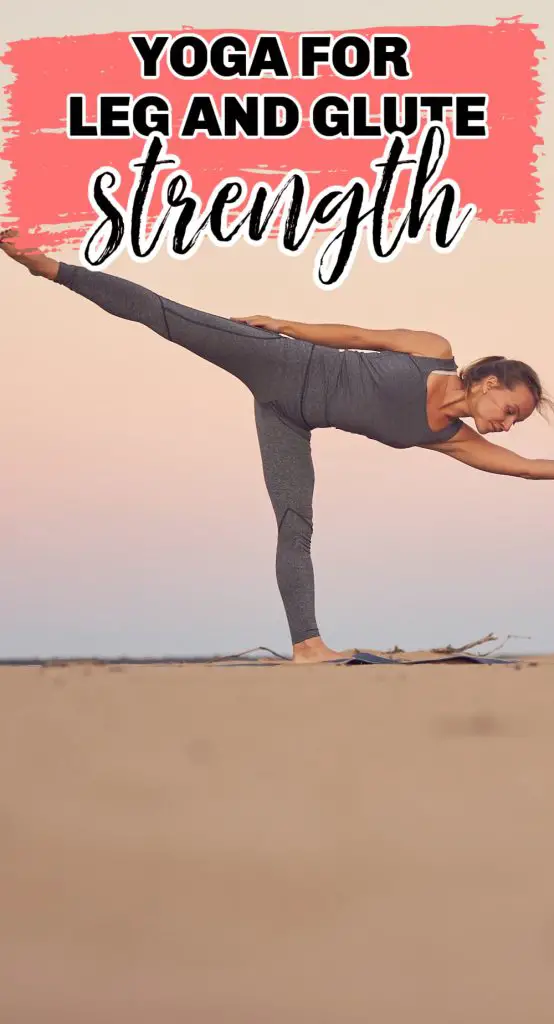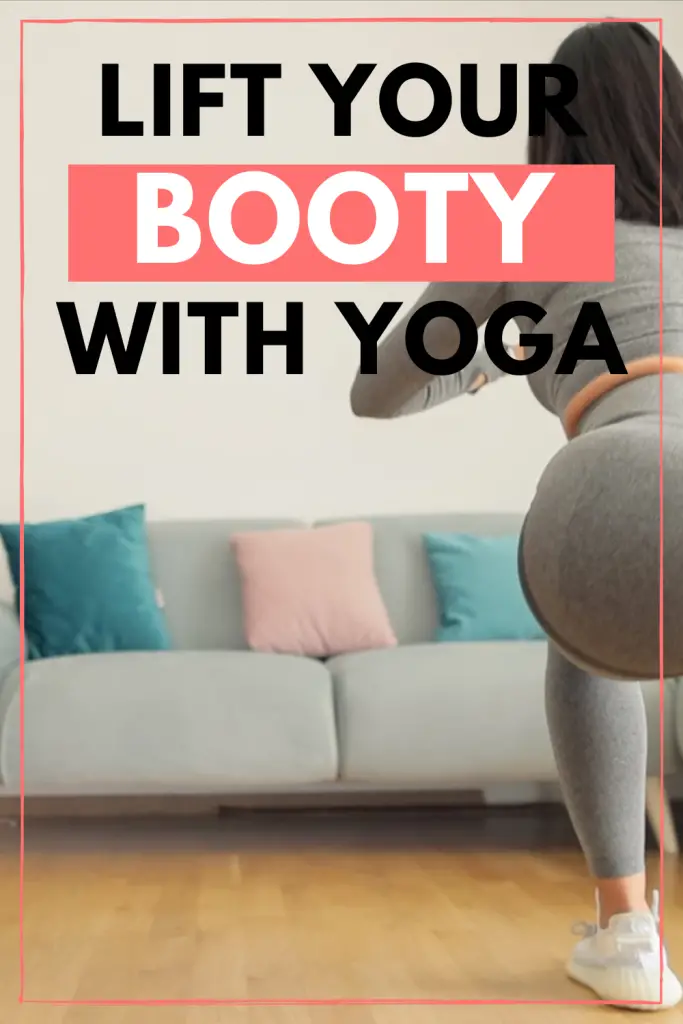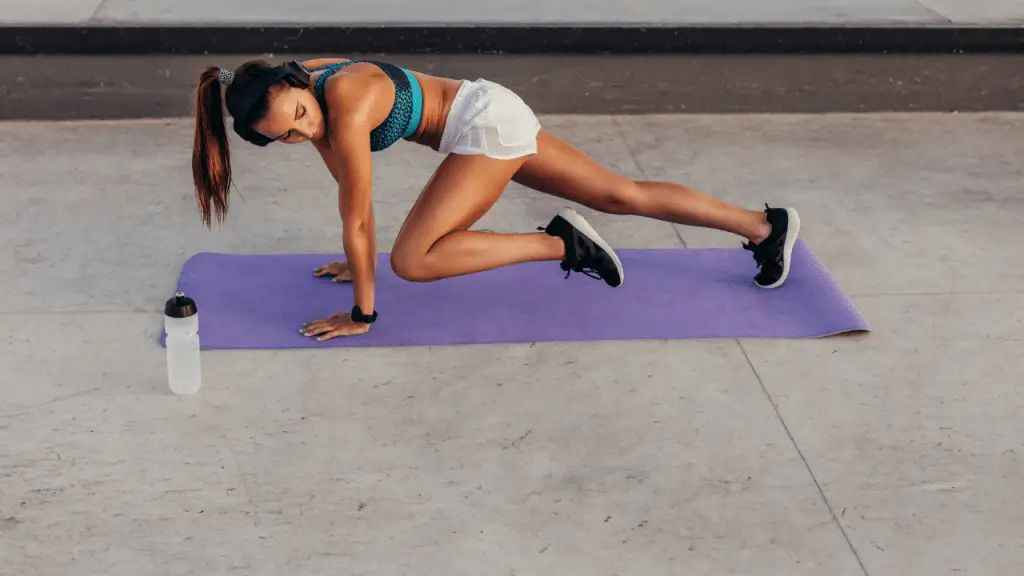When I started yoga, I didn’t realize that yoga for glute strength was a thing. Well, I guess I understood it could help build some amount of glute strength but not enough to make a visible difference in the shape of my butt. Two years later, I know that you can absolutely lift your booty with yoga alone. Let me show you how!
7 Yoga Poses for Glutes
Today’s follow-along routine is all about glute strength yoga, including my favorite yoga poses to lift your booty. Here are some of these poses:
1. Chair Pose (Utkatasana)
Stand with your feet together, bend your knees, and lower your hips as if sitting back in a chair. Keep your weight in your heels and engage your glutes as you hold the pose for several breaths. Furthermore, you can use one-legged chair pose variations like the Chair Pose with Leg Lift (shift your weight onto one leg and lift the other leg straight back behind you, keeping it parallel to the floor. Engage your glutes to maintain balance and stability. Hold for a few breaths before switching sides). For more tips and guidance, read this in-depth tutorial.

2. Crescent Pose (Anjaneyasana)
The crescent pose, or high lunge, is one of my favorite transition poses to move through all the yoga poses you will find in today’s yoga for glute strength routine.
From a standing position, step one foot back into a lunge position with the back heel lifted. Bend your front knee to a 90-degree angle, keeping it stacked directly above your ankle. Engage your glutes by pressing through the back leg and lifting the torso upright. Again, learn more about the crescent lunge here.
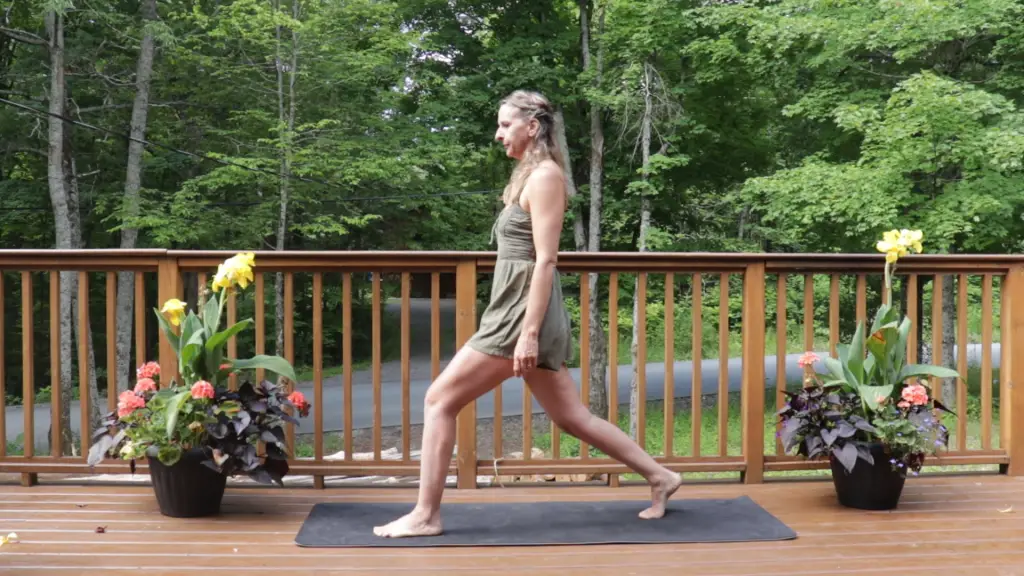
3. Airplane Pose (Virabhadrasana II)
Extend one leg straight back while leaning forward with your torso parallel to the ground, arms reaching forward. It resembles an airplane in flight and helps strengthen the glutes, hamstrings, and core muscles while improving balance and focus. When you have developed enough strength and balance, progress to the more advanced airplane version (lowering your chest to your thigh and moving towards the standing splits) or bring your arms forward into Warrior 3 Pose (Virabhadrasana III). Compare Airplane Pose and Warrior 3 Pose.
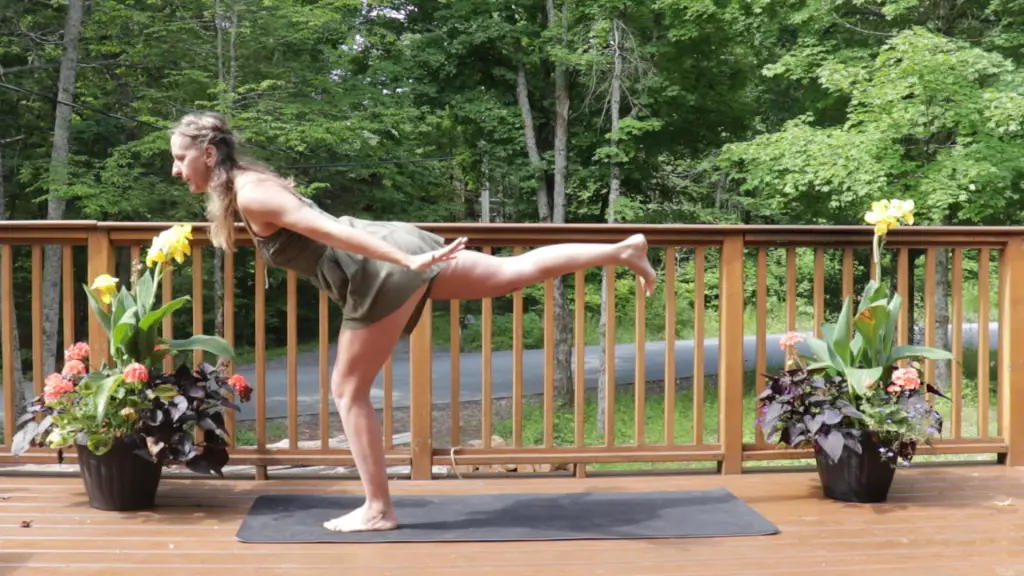
4. Half Moon Pose (Ardha Chandrasana)
Extend one (say the right) leg straight back, stack your hips, and lift your right hand towards the sky, forming a graceful half-moon shape with the body. In today’s workout, we will work on increasing your strength and balance for half moon by stacking your hips, then lowering them a few times. It’s an excellent way to increase your glute strength and lift that bootie!
Learn more about half moon pose by checking out this article.
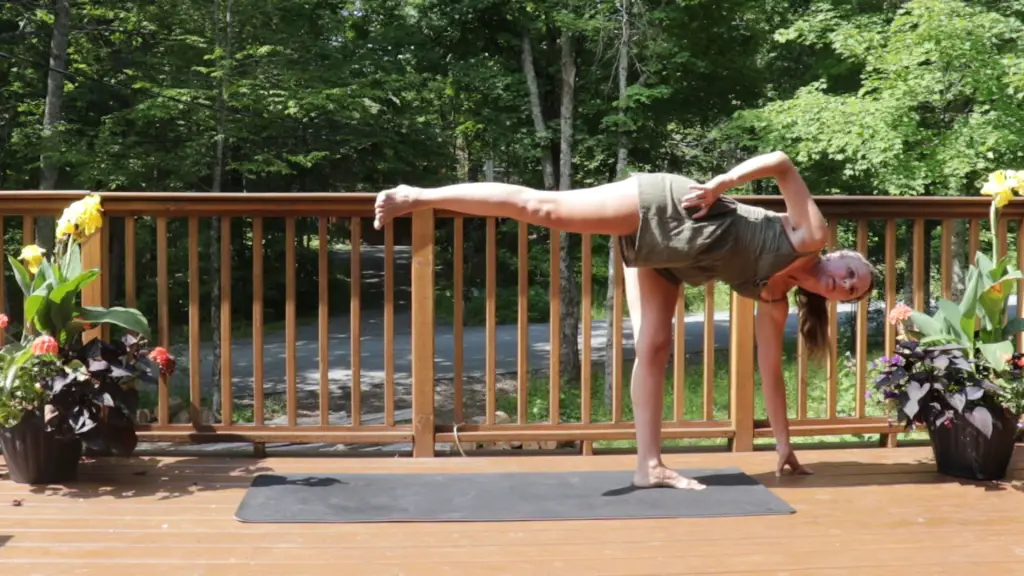
5. Standing Splits (Urdhva Prasarita Eka Padasana)
Stand on one leg while extending the other leg straight up towards the ceiling, creating a split-like position with the torso parallel to the ground. This pose helps to improve flexibility, balance, and strength in the legs and hamstrings.
6. Side Lunges (Skandasana)
Start in a wide-legged squat, then shift your weight to one side while extending the opposite leg to the side and bending the knee, creating a deep lunge.
Side lunges are excellent for glute strength, hip flexibility, and mobility. If you can’t lower in full Skandasana, follow the video modification and keep working on your flexibility. You may benefit from my Full-Body Flexibility Transformation Program, a step-by-step roadmap to becoming flexible for the inflexible.

7. Pigeon Pose (Eka Pada Rajakapotasana)
Bring one leg forward with the knee bent, placing the ankle near the opposite hip while extending the other leg straight back. This pose helps release tension in the hips and glutes, increases flexibility, and promotes a sense of grounding and relaxation.
The pigeon pose is typically used as a flexibility pose, but when done right, it will redefine your oga for glute strength practice. You will be surprised at how much it will transform the shape of your legs and glutes and how much you will feel the burn. The key is to keep your legs active as you “sit” in the pose. You are pulling your feet towards one another, creating a scissor action.
Yoga for Glute Strength Follow-Along Routine
And in case you are wondering: Is It possible to lift your booty with only yoga? The proof is in the pudding:
See more before/after photos in my 1-Year Yoga Transformation: Before and After Pictures.
Yoga Poses for Glute Pain
Yoga for glute strength may involve some yoga poses to relieve glute pain. If you are a beginner, you may feel some glute pain at first. Glute “pain” usually refers to hamstring pain.
Hamstring pain can occur due to various reasons. It may result from muscle strain caused by overstretching or tearing the hamstring muscles. Imbalances or weaknesses in the muscles, inadequate flexibility, overuse or repetitive strain, poor posture, and insufficient warm-up or cool-down exercises can also contribute to hamstring pain. It’s important to identify the underlying cause of the pain and seek appropriate treatment, which may involve rest, physical therapy, stretching, strengthening exercises, and a gradual return to activity. Consulting with a healthcare professional can help diagnose the issue and develop a personalized treatment plan.
To alleviate glute pain with yoga, you can incorporate the following yoga for glute stretch into your weekly routine:
- Pigeon Pose (Eka Pada Rajakapotasana): Start in a high plank position. Bring your right knee forward and place it behind your right wrist, with your right foot angled toward the left hip. Extend your left leg straight back. Lower your upper body down, resting on your forearms or extending your arms forward. Hold this pose for several breaths and repeat on the other side. Pigeon pose helps stretch and release tension in the glutes.
- Bridge Pose (Setu Bandhasana): Lie on your back with knees bent and feet flat on the floor. Press through your feet and lift your hips off the ground, creating a bridge shape with your body. Squeeze your glutes as you hold the pose for a few breaths. Bridge pose helps activate and strengthen the glute muscles.
- Reclined Pigeon Pose (Supta Kapotasana): Lie on your back and bend your knees. Cross your right ankle over your left thigh, creating a figure-four shape. Lift your left foot off the ground and interlace your hands behind your left thigh. Gently pull your left thigh towards your chest while keeping your right knee open. Hold this pose for several breaths and repeat on the other side. Reclined Pigeon pose helps release tension and stretch the glute muscles.
- Supine Figure Four Stretch: Lie on your back with your knees bent. Place your right ankle on your left thigh, creating a figure-four shape. Interlace your hands behind your left thigh and gently pull your left thigh towards your chest. Hold this stretch for a few breaths and repeat on the other side. This pose targets the glute muscles and helps relieve tension.
- Child’s Pose (Balasana): Start on your hands and knees, then sit back on your heels. Extend your arms forward and rest your forehead on the mat. Allow your glutes to relax and release any tension. Hold this pose for several breaths while focusing on deep, relaxed breathing.
Remember to listen to your body and modify the poses as needed. Yoga for glutes and hamstrings is about finding the right combination of strength and flexibility. You may enjoy some of my other routines like Full Body No Equipment Workout (No Jumping!) or Best Yoga for Mobility: Strength and Flexibility Flow.
Needing some help to get started with yoga? Check out my 5-Day Yoga Habit Challenge.
Yoga for Glutes and Hips
In yoga, the glutes (gluteus maximus, gluteus medius, and gluteus minimus) and hips work together in various poses to provide stability, strength, and mobility. Yoga for glute strength and yoga for hip mobility often go hand in hand. Here’s how they interact:
- Stability and Balance: The glute muscles are crucial in providing stability and balance during standing and balancing poses. They help to support the pelvis and keep it aligned, preventing excessive movement or tilting. Engaging the glutes activates the muscles around the hips and helps maintain a steady foundation in poses like Warrior series, Tree pose, and Standing Balancing poses.
- Hip Opening and Flexibility: The hips are a primary focus in many yoga poses that involve hip opening or deep stretching. The glute muscles contribute to these movements by assisting in hip extension, external rotation, and abduction. Poses like Pigeon pose, Butterfly pose, and Half Lotus pose target the glutes and hips, helping to increase flexibility and range of motion in these areas.
- Forward Folds and Backbends: In forward folding poses like Uttanasana (Standing Forward Bend) and Paschimottanasana (Seated Forward Bend), the glutes work in coordination with the hip flexors to allow the pelvis to tilt forward and deepen the stretch. In backbending poses like Bhujangasana (Cobra pose) and Urdhva Mukha Svanasana (Upward-Facing Dog pose), the glutes assist in extending the hips and supporting the lower back.
- Core Stability: The glutes are considered part of the core muscles in yoga. They work synergistically with the abdominal muscles and the muscles of the lower back to provide stability and support for the spine during various poses. Engaging the glutes helps to maintain a strong and stable core, improving overall posture and body alignment.
By understanding the interplay between the glutes and hips in yoga, practitioners can cultivate better body awareness, enhance stability, improve flexibility, and prevent injuries. Focusing on proper alignment, engaging the glute muscles mindfully, and listening to the body’s cues during yoga practice are essential.
You may enjoy How to Increase Hip Mobility: Try These Drills! to improve your hip mobility further.
